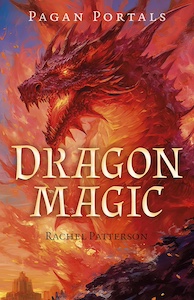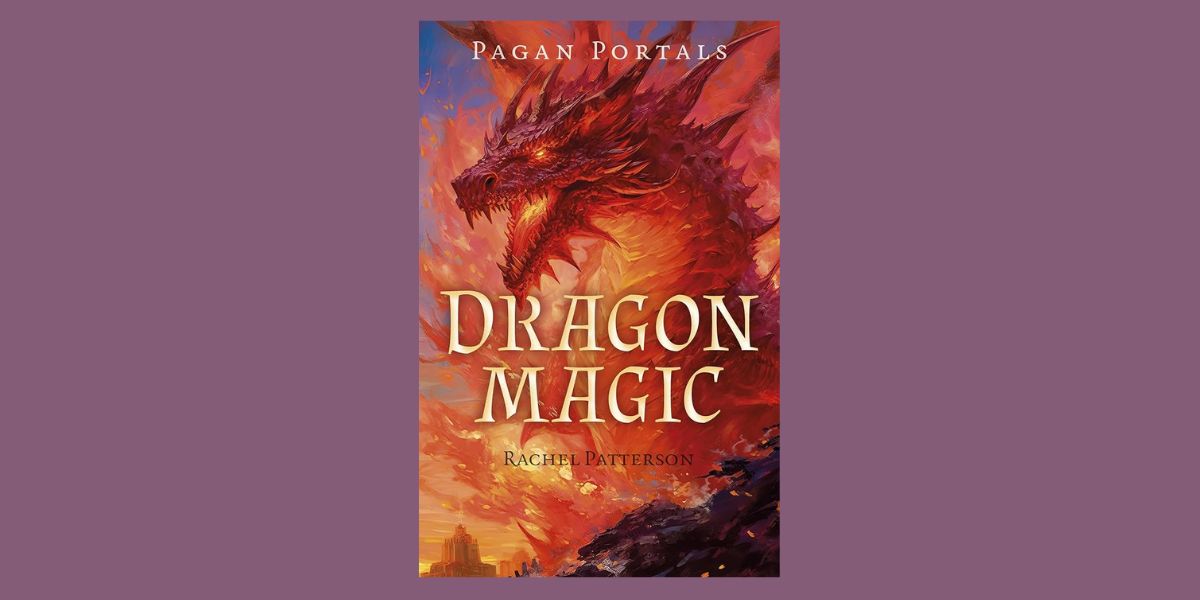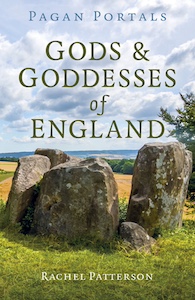
Pagan Portals – Dragon Magic, by Rachel Patterson
Moon Books, 1803414448, 128 pages, June 2024
In the ancient realms where myths intertwine with reality, dragon magic remains a force of unparalleled power, shimmering with the wisdom of ages and the mystique of untamed fire. Could these potent beings truly become one’s spiritual ally? Pagan Portals – Dragon Magic by Rachel Patterson, a fascinating exploration into the world of dragons, is a portal for those seeking to discover this realm for themselves.
As part of the Pagan Portals series, this book is designed to be an accessible introduction for those new to the concept of dragon magic, as well as a practical guide for seasoned practitioners seeking to deepen their connection with these ancient and powerful entities.
Patterson, a well-respected author and experienced witch, brings a wealth of knowledge and personal experience to the subject. She presents dragons not just as a mythological curiosity, but as ancient beings who can become our guardians in good time, assisting us on our path and looking out for us; connecting with dragons becomes a tangible and transformative practice.
The book is divided into four parts and also includes a prologue with information about what to know before beginning to connect with dragons along with Patterson’s personal relationship to dragons. All throughout Patterson’s writing is both engaging and informative, making complex concepts approachable without diluting their essence. Her emphasis on personal experience and intuition encourages readers to trust their instincts and develop their unique relationship with dragon energy.
“You cannot force a dragon to come to you, you cannot make one work for you. If a dragon feels you are worthy and can be trusted, then and only then will they even consider making a first introduction.”1
In “Part 1: Dragon Beginnings”, Patterson delves into the origins of dragons and then gives readers the basics of dragon 101, describing their habitat, feeding patterns, and offspring. She also covers topics such as the dragon constellation, Draco, in the stars and dragon lines, more commonly known as ley lines, on the Earth.
“Part 2: Myths, Legends and Stories” lays out for readers dragons well known in fiction and mythology. Fictional dragons include Smaug from The Hobbit, Jabberwocky from Through the Looking Glass, and the ones that appear in Harry Potter, along with a few others. Meanwhile, the mythology section is nearly triple in length and covers dragons from all over the globe: Mayan Quetzalcoatl, Hindu Vritra, St Michael and the Dragon, the Chinese Long Dragon, Old Norse Sigurd and Fáfnir, plus more. This section demonstrates how dragons are universal to cultures worldwide.
Next, Patterson moves into “Part 3: Dragonology”, teaching readers the many types of dragons. I appreciate how she candidly notes this topic could be a book on its own and shares her process of reading the myths and legends to “look at the stories and what the main themes are”2 within them. She says, “I look at the landscapes, the habitat and appear of each dragon”3 to get a feel for the “characteristics and magical energies of each one”4
While I plan on doing my own research, as Patterson suggests, I am amply grateful for the way she describes all she has learned about each dragon type. I had absolutely no idea there were so many kinds! To name a few, there’s serpent dragons with wings, Gwiber, whose magical characteristics are wisdom and transformation; the Nāga in India who is known for “Underworld connection, water magic, prosperity, Otherworld portals, protection”6 All of them are so awesome! I had a great time looking each one up online to see artistic renderings of them.
But my favorite part of this book is Patterson’s magic guidance in “Part IV: Dragon Magic”. Here Patterson shares with readers her work with dragons as a starting point for their own journey. She writes:
“My experience with dragons and dragon magic is one of power, strength and hard work. Dragons are ancient, they are primordial and do not tolerate being summoned nor do they appreciate any half-hearted lack of commitment.”7
She really emphasizes the need for respect and manners when forming a relationship with dragons, as noted in the above quote. I appreciate her honesty, as it honors the sanctity of the bonds between human and dragon, if the dragon so deems us worthy.
To first establish contact, Patterson offers meditations to bring readers into the realm of dragons. Then she goes into setting up an altar, creating a dragon candle and oil blend, and offerings to provide. Depending on the elemental nature of the dragon one is working with, Patterson goes into more detail about their qualities, color of candle one might use, and specific incense blends.
The remaining chapter covers dragon sigils, spells, rituals, energetic techniques (grounding, protecting, cleansing), crystals, herbs, and other miscellaneous wisdom Patterson has picked up over the years. I really enjoyed how she mentions readers can connect with a different dragon for each season or sabbat, noting dragons “do seem to recognise the changing of the seasons and the flow of energy that comes with the sabbats.”8 My plan is to do one of the meditations for Lammas coming up soon to see if there’s any dragons that are interested in connecting with me until Mabon.
Overall, Pagan Portals – Dragon Magic is a valuable resource for anyone interested in strengthening their connection with dragons. Whether you’re seeking to incorporate dragon magic into your daily life or seeking to perform more elaborate rituals, Patterson provides a sturdy framework to get started, structuring the guidance to accommodate different levels of magical experience levels. Soon enough you’ll be able to tell legendary tales as someone who has dared to seek the counsel of dragons.
Alanna Kali is an astrologer, numerologist, and pioneer spirit that loves to explore life through the lens of depth psychology. She has a passion for studying the humanities and social trends. Her academic work is centered upon reuniting body, mind, and spirit through eco-psychology. She loves reading, spending time in nature, and travel.


